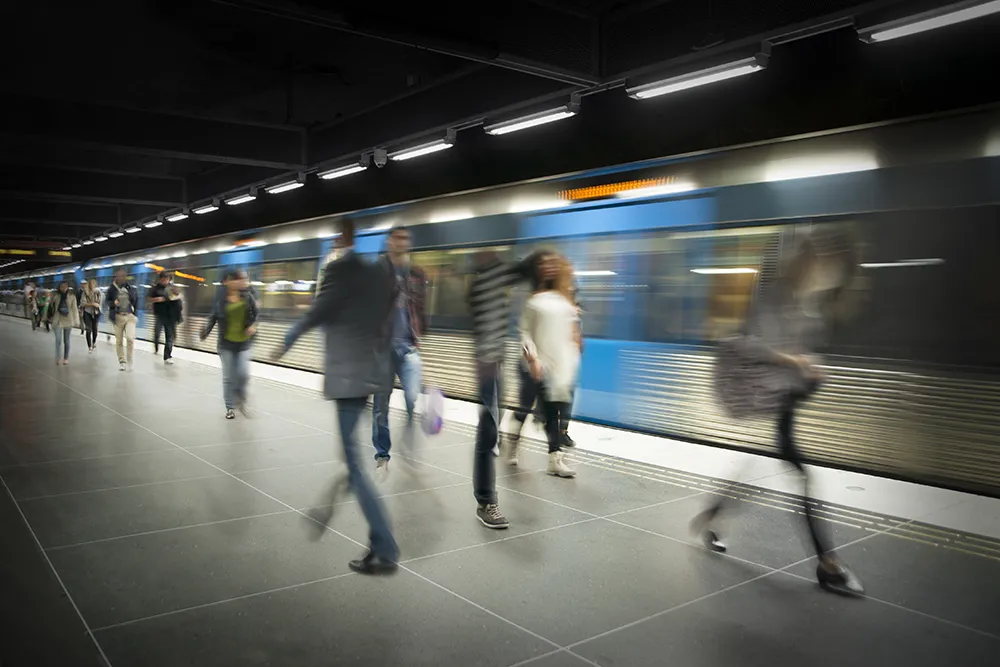
The Urban Cooling + First/Last Mile Strategies in Los Angeles-Canoga Park Project explores resilient streetscape solutions that mitigate two critical planning issues impacting Los Angeles: extreme heat (urban cooling) and limited safe active transportation access (first/last-mile).
Within the next 20-30 years, climate scientists predict that the average temperature in LA will rise by 4-5°F, with the occurrence of extreme heat days (when temperatures exceed 95°F) dramatically increasing in LA’s San Fernando Valley (the project’s location) to 92 days per year.
In addition, historically car-centric planning in LA has contributed to the city’s average rate of children and older adults who die while walking to be double the national rate.
Although LA is experiencing increased investment in public transit and active transportation projects, these projects often lack the essential urban cooling and green infrastructure elements that encourage residents to safely and comfortably walk and cycle.
Design toolkit
In response to these challenges, the Urban Cooling Project acts as a key case study that lays the groundwork for the City of LA to enhance the resiliency and liveability of its streets through a three-pronged initiative. The City prepared a toolkit of design solutions that reduce heat while facilitating comfortable and safe access to transit - encouraging mode shifts toward more sustainable forms of transportation.
The City also initiated a robust community engagement process that vetted these design concepts for applicability across major LA street types, resulting in engaging video renderings capturing how the Project will look and feel. Lastly, the City developed a replicable and viable framework that positions it to secure grant funding to bring these concepts to life in Canoga Park and throughout LA.
Over the course of the project’s planning process, the team evaluated existing conditions and conducted traffic counts; compared effectiveness, limitations and co-benefits of urban cooling technologies and first/last-mile strategies; and collaborated with more than 650 community members to understand key needs and define design strategies.
Cooling strategies
The selected urban cooling strategies considered their applicability to LA’s major road typologies: a major arterial; a neighbourhood street; and a multi-use trail. Additionally, the project expanded on the City’s Cool Streets Program’s street surface-coating studies which demonstrated how ‘reflective cool pavement’ provides an average 11°F temperature reduction compared to the surrounding regular pavement during the hottest hours of the day.
The Urban Cooling toolkit further enhances the effectiveness of the reflective cool pavement by pairing this innovative technology with green infrastructure and active transportation strategies including expanded urban tree canopies, landscaped parkways, shade structures, separated bikeway buffers, and first/last-mile facilities.
In 2021, the project was awarded additional grant funding to implement its urban heat and transit design solutions and it continues to be a model of holistic streetscape planning. It demonstrates how the City of LA is making strides to retrofit its street assets for future climate resiliency while meeting the safety and design needs of non-motorised users by connecting them to their destinations and LA’s public transit system.
Receiving the IRF Global Road Achievement Award on behalf of the City of Los Angeles, Keith Mozee, executive director & general manager of the Bureau of Street Services (StreetsLA), City of Los Angeles, noted: “Our holistic approach to streetscape planning is an example of how street improvements can combine the goals of safety and climate resiliency. This kind of integration is the future of infrastructure.” ITS
• This is an edited version of an article which first appeared in World Highways
Mission critical
Extreme heat and transit access are two critical problems impacting the health and quality of life for people across Southern California. StreetsLA identified Canoga Park, a community in LA’s San Fernando Valley in which heat is a pressing health and safety issue, as the neighbourhood in which to explore design concepts related to cooling surroundings and improving access to transit.
StreetsLA received an Adaptation Planning Grant from Caltrans and launched its study in December 2018 with support from a consultant team led by Alta Planning + Design. The focus was on a study area within a 10-minute walk from the Sherman Way Station Orange Line station. In 2019, the project team evaluated existing conditions and conducted traffic counts; identified potential urban cooling and first/last-mile strategies; and collaborated with more than 650 community members to understand key needs and refine proposed strategies.

Urban areas—with impermeable, dark-coloured surfaces like parking lots, roads, and roofs—can experience higher surface temperatures throughout the day, and retain heat into the night, increasing electricity usage and posing added health risks. The simple addition of trees can help reduce extreme heat and improve air quality, with mature trees cooling surface temperatures considerably. Wealthier neighbourhoods tend to enjoy higher concentrations of trees than lower-income communities.
Encouraging more environmentally-friendly means of transport, by making it easier for people to walk, bike and ride public transit – rather than drive - helps to mitigate climate impacts. However, walking or biking in 100°F heat can be dangerous.
Cool paving areas increase pavement reflectivity, thereby lowering temperatures and providing immediate cooling benefits. More trees would increase comfort and lower temperatures, as well as filtering air and water. Complete sidewalk networks, enhanced bike facilities, improved crossings and streetscape amenities encourage people to walk and bike more to local destinations and transit. This improves safety and expands the ways all residents - especially those who do not have access to a car - can reach jobs, housing, recreation and services.
Source: Urban Cooling + First/Last Mile Strategies in Los Angeles-Canoga Park Project
GRAA: showcasing industry excellence
The International Road Federation’s Global Road Achievement Awards (GRAA) is a one-of-a-kind competition to recognise innovative road projects and exemplary people that place the road industry at the forefront of worldwide social and economic development. Instituted in 2000, the Awards have distinguished more than 185 programmes, projects and products from around the world.
• For more information, go to: www.irf.global/graa










